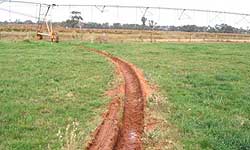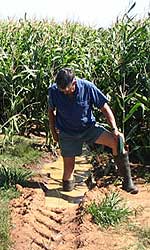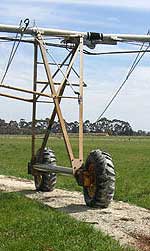Centre pivot wheel rutting
You need to be aware of the potential for wheel rut problems to develop, and to learn how to minimise them. Problems often reduce as the tracks become compacted, and can be minimised with appropriate management.
How wheel ruts develop
 Wheel tracks often develop into ruts as a result of excessive water application on the wheel tracks and compaction by the tower wheels trafficking over the wet soil. Each tower and the span it supports, full of water, can weigh up to four tonnes.
Wheel tracks often develop into ruts as a result of excessive water application on the wheel tracks and compaction by the tower wheels trafficking over the wet soil. Each tower and the span it supports, full of water, can weigh up to four tonnes.
Pasture or crop originally giving some strength to the soil is cut up and disappears, with the soil becoming smeared so that water in the rut does not seep away between irrigations. The soil is compacted and displaced sideways, heaving up beside the forming rut. The moving wheels push water along the rut, continually aggravating the smearing and compaction so that the ruts get progressively deeper.
Duplex clay soils are the most prone to rutting, but ruts can be a problem on all soils, except perhaps very sandy soils.
While the sprinklers distribute water relatively evenly over the irrigated surface, the towers intercept some of the throw from the sprinklers, and this water runs down the towers onto the wheel track. Measurements have shown that up to three times the depth of water being applied in the irrigation is applied to the wheel track through interception of the sprinkler pattern by the tower (Foley and Raine, 2001). This additional water is the main cause of the problem.
Why wheel ruts are a problem
Ruts can be quite variable – the machine can bog where it has to climb out of a hole.
 A minor occurrence of rutting is generally not a problem, but serious rutting can result in machines bogging and stopping, or even damaging the machine. Ruts are often not uniform in depth because of variations in the soil.
A minor occurrence of rutting is generally not a problem, but serious rutting can result in machines bogging and stopping, or even damaging the machine. Ruts are often not uniform in depth because of variations in the soil.
A tower climbing out of a deeper section of rut can slip and bog (stop), even though all wheels on a machine are driving. When a tower stops, it gets out of alignment with the other towers, which causes the machine to shut down. An occasional stoppage may be tolerated, but more frequent stoppages severely reduce the reliability and labour saving advantages of the machines.
The drivelines of modern machines are generally fairly robust, but continued operation with the increased stresses occurring in deep ruts may cause failure. Most manufacturers consider their warranty void where machines operate with ruts deeper than 100mm.
Wheel rutting can be minimised by:
- keeping applied water off the wheel tracks
- increasing the load-bearing strength of the soil along the wheel track lines
- reducing the pressure applied to the soil by the wheels.
Options for managing wheel ruts
Dry-wheel pack
Fitting half-throw (half circle) sprinklers on solid drops adjacent to each tower (known as a dry-wheel pack) greatly reduces the amount of water hitting the tower and falling on the wheel track.
Depending on the spacing and throw of the sprinklers, three or four half-throw sprinklers may be needed to keep the wheel track dry.
Solid (galvanised steel pipe) drops are needed because the side thrust of the half-throw sprinklers causes them to swing about on the standard flexible hose drops. Alternatively, some suppliers fit half-throw sprinklers adjacent to the tower on a bar attached to the tower.
A dry-wheel pack or boombacks should be fitted to new machines, unless you are confident that ruts will not occur (such as on a sandhill).
A dry-wheel pack or boombacks should be fitted to new machines.
Smaller nozzles should be fitted to the half-throw sprinkler immediately adjacent to the tower; otherwise the full flow from the half-throw sprinkler will over-irrigate the area adjacent the tower.
The two or three half-throw sprinklers not immediately adjacent to the towers probably don't need to have smaller nozzles fitted, but can be turned slightly to irrigate close to the tower and behind it.
If ruts are still forming, they can be set so that they do not irrigate the wheel track line at all.
Some test runs may be necessary to get the optimum alignment and flow rate of the half-throw sprinklers.
Boombacks
 A boomback is a boom that re-locates the sprinklers normally adjacent to the towers to behind the wheels. With half-throw sprinklers on the boombacks aligned to throw behind the tower, this greatly reduces the amount of water intercepted by the tower and applied to the wheel tracks ahead of the wheels in the current pass.
A boomback is a boom that re-locates the sprinklers normally adjacent to the towers to behind the wheels. With half-throw sprinklers on the boombacks aligned to throw behind the tower, this greatly reduces the amount of water intercepted by the tower and applied to the wheel tracks ahead of the wheels in the current pass.
Boombacks maintain the uniformity of the sprinklers — or improve it, because the towers are not intercepting water. The higher average application rate of the half-throw (but full flow) sprinklers may aggravate any ponding or run-off tendencies.
While the use of boombacks will keep most of the applied water off the wheel track for the current irrigation, irrigation of the wheel track behind the towers may still allow some rutting to occur with subsequent passes. Typically the two to four sprinklers adjacent to each tower (depending upon the spacing and throw of the sprinklers) would be carried on boombacks. One boomback may carry two or three sprinklers on a tee (at the standard spacing).
Where a machine irrigates in both directions (a lateral move, or part-circle pivot), boombacks can be fitted to both sides and operated as required by manual or automatic valves . Alternatively, the boombacks can be hinged and swung around for the reverse travel direction.
Boombacks cost more than half-throw sprinklers on solid drops and may not be as effective as the half-throw sprinklers alone to keep the wheel track dry.
Boombacks with half-throw sprinklers maintain (or improve) the distribution uniformity, where half-throw sprinklers will reduce the uniformity and may cause some productivity loss close to the wheel track because of reduced water application there.
It is impossible to keep all water off the wheel track and fully irrigate immediately beside it.
Reduce the sprinkler flow rate at the towers
Some people choose to remove a sprinkler (blank it off) or fit a smaller nozzle at the towers to reduce the amount of water hitting the towers and wetting the wheel track.
While this helps — it reduces the irrigation uniformity and is not as effective as half-throw sprinklers or boombacks.
Alternatively, a valve can be fitted into the drop (above the regulator if fitted) so that it can be turned off for alternate irrigations if there is too much water being applied near the tower. This can be beneficial even with half-throw sprinklers fitted. The valve should not be used to reduce the flow — this will affect the regulator (if fitted) and the throw of the sprinkler. Smaller nozzles should be used if the flow needs to be reduced.
Span pipe drains
The span pipe drain valves, which automatically drain the span pipe when the machine stops, are located at the lowest points on the span pipe, which are above the towers. So whenever the machine stops — much of the water in the span pipe (some 1000L in a 162mm x 50m span) drains onto the wheel track. This can aggravate the problem at a regular stopping point, even when half-throw sprinklers keep water off the wheel track during irrigation.
One solution is to remove the automatic valve and connect the drain hole by a hose to a tee in a suitable sprinkler drop, so that the water drains through a sprinkler well away from the wheel track. The tee in the drop should be installed above the pressure regulator (if fitted), so that the sprinkler runs at the correct pressure while in normal operation.
Alternatively, the valve can be left in place, and a fitting placed over the valve, which can operate normally. A hose connected to the fitting and fixed to the truss rod can discharge the span pipe water several metres away.
Larger wheels and tyres
Larger wheels and tyres can be fitted to increase the surface contact area, which reduces the pressure on the soil. Tyre pressures at the low end of the recommended range will maximise the surface contact area of a given tyre.
Larger wheels and tyres increase the load on the drive-line, and increase the risk of failure, particularly if wheel ruts develop and the machine tends to bog.
Existing ruts should be filled in before fitting larger wheels and tyres, as the larger tyre will tend to deform in the rut and widen it, placing greater stress on the drive-line.
A wheel and tyre size larger than the standard 14.9 inches × 24 inches can be specified when ordering a new machine. Wheel and tyre sizes such as 16.9 inches × 24 inches, 16.9 inches × 28 inches, 11.2 inches ×38 inches or 18.4 inches × 34 inches have lower ground pressure (Foley & Raine, 2001).
However, fitting an existing machine with larger wheels and tyres to solve a wheel-rutting problem may not be effective on its own.
Some manufacturers now offer towers with a third in-line wheel, or dreadnought or tracked options to achieve lower ground pressures. Such measures should not be necessary when dry-wheel pack options are fitted.
Light irrigation applications
More frequent light irrigations allow the wheel track to dry out more, particularly if most water can be kept off the track. This is particularly desirable for a new site to allow compaction of the wheel tracks.
Build up and compact wheel tracks
 Wheel tracks can be built up and compacted, preferably prior to ruts developing. This will stop water pooling, and so help stop ruts forming. Gravelling the tracks will help to stabilise them.
Wheel tracks can be built up and compacted, preferably prior to ruts developing. This will stop water pooling, and so help stop ruts forming. Gravelling the tracks will help to stabilise them.
However, if tracks are built up, they should be kept flat on top — pivot structures can be damaged when the wheels tend to track off-line from a peaked track.
Regular filling in of any developing ruts with a terracer blade, road grader or check-bank crowder is desirable.
Built up wheel tracks should allow for drainage. Tracks should not be built up across drainage lines, and crushed rock applied to wheel tracks should not be above the natural surface, so that drainage across the track is not restricted. Ideally, wheel tracks across a drainage line should be excavated by approximately 20cm and filled with crushed rock to surface level before a rut forms.
Cultivation (particularly deep cultivation) of the wheel tracks should be avoided, so that the developing compacted area is not destroyed.
Track sacks have been tried in the cotton industry. These are permeable bags containing polyacrilamide ('PAM' - used to stabilise clay structure) tied to the tower cross bar, which drip PAM dissolved by water from the sprinklers onto the wheel track. This hasn't been very successful; keeping water off the track is more effective.
Recommendation for new sites
The key to managing wheel tracks is keep water off them as much as possible while irrigating, and to maintain a compacted roadway, preferably raised so that any water drains off.
- Fit half-throw sprinklers on solid drops to three or four drops at each tower (depending on the spacing and throw of the sprinklers), to keep the wheel track dry.
- Alternatively, boombacks carrying three or four half-throw sprinklers may be specified on a new machine, or retro-fitted if the distribution uniformity of the half-throw sprinklers alone is unacceptable.
- Larger tyres and wheels than standard should be considered.
- Apply light irrigations, at least until the wheel tracks are reasonably well compacted.
- Form up the tracks and compact them to form a firm roadway (before they get too wet to compact), and maintain them as required. If ruts are forming anyway after several irrigations, in depressions perhaps, fill them with crushed rock to create a firm base.
Costs to prevent wheel ruts
Fitting half-throw sprinklers and solid drops to an existing machine costs about $60 per drop (plus fitting), or $1400 for a machine with three drops on each of eight towers.
Boombacks cost about $160 each (plus fitting), or $3850 for the above machine. For lateral moves or part circle pivots which have boombacks fitted for both travel directions, this cost is doubled. Automatic valves for changing travel direction may significantly increase the cost.
Recommendation where wheel ruts have developed
- Fit half-throw sprinklers on solid drops to keep water away from the ruts. Boombacks may be fitted if the distribution uniformity of the half-throw sprinklers alone is unacceptable.
- Dry ruts less than 30cm deep can be cultivated 80mm deep over 2-3m width and soil crowded or graded over the rut, followed by compaction with the tractor or grader wheel.
- With deeper ruts, the surface beside the ruts (up to a metre beside the rut) will be raised due to the heaving up which occurred as the rut formed. This can be cultivated (when dry) and crowded over the rut with any imported material considered necessary, and compacted at a suitable soil moisture content.
- Importing soil to fill ruts should be a last resort, because of the expense involved. Imported soil should be predominantly clay that will compact well. Silty material is less likely to compact well and remain firm.
- Ruts should not be filled in while there is still water in them or irrigation is still occurring. The soil would simply be turned into slurry by the wheels. If the ruts can't be dried out, excavation of the wet, unconsolidated soil may be necessary to achieve a firm base before filling.
- If the ruts will not dry out enough to fill them, sand and gravel or crushed rock (ideal, but more expensive) can be used to provide a firm base to allow continued operation until they can be dried out and repaired.
Case study
An 8-tower, 400m long centre pivot was installed. It developed 11km of wheel ruts up to 50cm deep.
Recently, some $25,000 was spent to rehabilitate these ruts by excavating the wet slurry, filling with clay and compacting. It would have cost around $4,000 at the installation stage to fit half-throw sprinklers and boombacks. Repairing any developing ruts annually requires much less effort.
Prevention or minimisation of wheel ruts is preferable and cheaper than dealing with them after they have developed.